You’re listening to Burnt Toast!
I’m Virginia Sole-Smith, and today my guest is the delightful .
Julia is a New York Times bestselling cookbook author, and today we’re celebrating her brand new cookbook What Goes With What. WGWW is built on the simple premise that if we understand what makes food delicious, we can feed ourselves well. Nobody understands this better than Julia, who has been excavating the rules, limitations, and hidden diet mindset of food writing for years now, and in doing so, offers us all a better, more straightforward way to think about food and making meals happen.
If you have ever felt overwhelmed by the deeply loaded question of “What’s for dinner?” Julia’s work is a safe place to start figuring it all out.
Julia also writes a weekly newsletter called
. She teaches live cooking classes most Sunday afternoons, and she’s a part-time farmer and competitive power lifter. Julia lives in the Hudson Valley (near me!) with her spouse Grace and their many pets, and I know you are going to love today’s conversation.You can order What Goes With What through the Burnt Toast Bookshop. Don’t forget, you can always take 10 percent off that purchase if you also order (or have already ordered!) Fat Talk from Split Rock Books! (Just use the code FATTALK at checkout.)
PS. If you enjoy today’s conversation, please tap the heart on this post — likes are one of the biggest drivers of traffic from Substack’s Notes, so that’s a super easy, free way to support the show!
Episode 164 Transcript
Virginia
Oh my God, my dishwasher. Julia. I’m so over it.
Julia
Can I tell you a story that might make you feel better?
Virginia
Yes, please. I would love an uplifting or just in the trenches dishwasher story.
Julia
It’s an in the trenches story. Grace and I had an old dishwasher that came with our house when we bought our house. So it was probably at least 20 years old. But it worked great, you know? And then it stopped working. So we were like, “oh shit, we finally have to get a new one.” So we did everything you’ve been through. We measured, got the new one, they took the old one out, they put the new one in. It fits, but it sticks out a little, which annoys us to this day. I feel like all the old appliances just worked better and were simpler. So we just don’t like our new one.
But the thing that sucks is that when we took out the old one, we realized that one of us, by mistake, had turned off some auto setting off or something. So I think it was working!
Virginia
It wasn’t even broken?!
Julia
And then we were just like, “Well, we got this nice new one, we’ll just use it.” But it just doesn’t work as well and we are still upset about it and it’s been years.
Virginia
Oh my God. I mean the embarrassing story I won’t tell the whole Internet—although we’re recording now, maybe we’ll keep it—is somewhat similar. We had the dishwasher that came with the house that worked, that was 20 years old, that worked great until it didn’t. It died like a year ago. We bought a new dishwasher and Dan’s friend told us to buy this fancy GE one that has two drawers. He was like, “It’s going to change your life. It’s so great, blah, blah, blah.” And I did really love it for like, six months, because the ergonomics of having a big top drawer for unloading is really nice. But it clogs constantly because it’s two filters and they’re small, and it’s really meant to be in some rich person’s butler’s pantry for the wine glasses.
Julia
It’s for a fake kitchen.
Virginia
Exactly. It is not for everyday baked-on mac and cheese duty. So it’s been driving me nuts for ages, and I had a repair guy come out, and he just shamed me for not cleaning it enough. He was like, it’s $150 for the call. It’s not broken. You just don’t clean it. I was like, I hate you? And then it started leaking water all over the floor. So this was a super high end, fancy dishwasher that has brought me nothing but pain. And so now I’m having to buy another dishwasher, maybe it’s like 18 months later? Like, it’s way too soon to have to be going through this! I feel like all I do is deal with dishwashers.
And then I ordered a new one and it arrived, and it did not fit. And I had to send it back and start again! I don’t understand. Why is 24 inches not the same to everybody? Why can’t the industry agree on standards?
Julia
What did you say? It was so funny.
Virginia
Why are women’s clothing designers making dishwashers? Literally. It’s blue jeans sizing all over again. And the installer didn’t understand why I was mad about it. He’s like, “Well, for KitchenAid, 24 inches is 24 and a quarter, but you only have 23 and three quarters.” But they all say 24, that should not be allowed. You have a standard, it’s called inches. Just use the same standard.
Julia
It drives me so nuts.
Virginia
Why are we living like this? I don’t know. Meanwhile, I have so many dirty dishes.
Julia
Paper plates!
Virginia
I think it’s takeout tonight. But anyway, now let’s record an episode about cooking, which is something I’ll do again some day.
Julia
I mean, the dishwasher is not unrelated.
Virginia
All right, all right. Let’s get into this. We are going to talk about your new cookbook. So why don’t we just do that?
Julia
Great. I’m so happy to be here. I feel like any excuse to just chat with you makes me very happy and I’m so excited to tell you and everyone who listens about my book. It is called What Goes With What. And I am just so happy with it.
It is a book of not just recipes, but also these charts that kind of help you understand the recipes. There are 20 charts in the book, and each chart has a formula to show you the infrastructure behind things like salad dressings, soups, baked goods, meatballs. And then there are five examples on each chart for how to use this formula. My hope is that not only will that give you 100 recipes total that you can rely on, but it also gives you this way to just think about cooking. You can reference the charts and then riff on things, and learn to kind of trust your your instincts and use what you have in your kitchen and not run to the grocery store to buy something else. So it kind of gives you this framework in addition to the recipes themselves.
Virginia
I can’t underscore enough for people, if they haven’t seen your charts, like, they’re mind blowing. It’s like, I suddenly understand salad dressing in a whole new way. I remember when you first started putting them on the newsletter and I think I texted you, and I was like, “What if you did that chart thing, but you did it for salad?”t And you were like, “Of course I’ve done a salad one, of course I’ve done a soup.” And I was like, oh my God, it’s like being inside the matrix.
Julia
The charts were sort of born in my newsletter. It was just something I started doing for fun and a way to kind of give people a tool that I hoped would be helpful to do exactly what you just described, to feel like something was a little bit unlocked, and you could just wrap your head around it. A
nd it was really funny to me when I first started sharing them, because I was like, doesn’t everyone think like this? Like, I just thought it was a given.
Virginia
No, not all of our brains work like yours.
Julia
I got such a positive response, that’s why I ended up making it into a book. But I heard from so many people who are either autistic or neurodivergent or identify somewhere on the autism spectrum, who just told me that this was the first time they really understood cooking. It just made sense in a way that hadn’t before. Which led me on a really interesting path to understand how does my brain work? And just to realize we all learn things in such different ways. And I just think the more tools, the better. And I think the charts are a very helpful tool if you’re someone like me who is a visual learner. If you’re someone like me who can get overwhelmed with a lot of information. The charts in the book, just like in my newsletter, they’re all in my handwriting. They’re no spreadsheets. It’s not too much information, they are all contained to one page. There are only five examples. It’s lots of stuff, but it’s done, I hope, in a very accessible way.
Virginia
I often feel about recipes the way I feel about when we used to print out the Map Quest directions to drive somewhere. I would know that the smart thing to do would be to read through the whole thing before I started driving. But I never in my life did that. So I would just be stressed out and holding the print out, like where do I turn, and what’s happening? And you lose the printout. It’s why I am not great at not getting lost when I drive places. Thank you, GPS, for keeping me alive.
But similarly, with recipes, they throw a lot at you, and it can just be a lot for your brain to take in. You try to just step-by-step through it. But then often you’re like, “Oh, wait, but I wish I’d known that this thing is happening now. I should have known about that earlier.” It can get overwhelming.
Julia
Yeah, I think the comparison to driving and Mapquest is so on point. Sometimes I’m like, how did my parents get anywhere?
Virginia
I can tell you, we were lost a lot. My mom has a really good sense of direction, but my dad does not—love you, Dad! We were lost frequently, and there were some stressed out car rides.
Julia
Same. I try not to do too many like binaries, but I think there is a little bit of like “you can divide the world into two” when it comes to recipes. People who either follow recipes or people who don’t. And my kind of funny truth about my life is that I write recipes for a living. I love writing them. I love developing them and testing them and writing them. But I never follow recipes unless I’m testing them.
When I’m just cooking, when I’m just in my kitchen making a meal, I’m never following a recipe. So I’ve always had this kind of, I don’t know, question or sort of tension of like, what am I doing?
Virginia
What am I telling people to do?
Julia
I think landing on the charts has really unlocked something for me, because they’ve given me a way to express how I cook and how I think about cooking, which is by thinking in these categories and frameworks, and then being able to riff. So I think for folks that do feel really overwhelmed by cooking, I think recipes have a vital role and are the way a lot of people learn, how they learn and how they learn to trust themselves.
So I think they absolutely have a role. But getting to incorporate them into these charts, I think my hope is that people will feel like they can rely on the recipes, use them. I think they’re all great. I really enjoyed them. And also, if you find you’re out of one ingredient, but you have another that kind of serves the same purpose, you can try it and just develop that kind of ease in the kitchen and that confidence to just just make a meal and not worry about it too much.
Virginia
It’s very empowering to cook your recipes and cook from your newsletter and from these charts, because it just makes me feel like, “Oh, it’s okay. Julia’s got me, I can go off on this other direction.”
Julia
Hearing you say that really means a lot to me. That’s my hope in my work. So that’s really meaningful to hear. And in terms of the overwhelm you or lots of people can feel, just to use another metaphor, I think that a lot of people feel about cooking the same way a lot of people feel when they walk into a hardware store and they’re not familiar with everything. You know you’re there for a reason. But you kind of don’t know where everything is. You don’t know what everything means.
Virginia
You don’t know what other parts you need to go with the part you know you need. It turns out, actually there are five other components.
Julia
My hope as a cookbook author is that I’m that person in the store who you’re not afraid to ask a question, and who will bring you to the right thing and be like, actually, this one works really well, and it’s cheaper than you thought. It’s not going to take that much time.
Virginia
You’re the retired dad who works at Home Depot and helps me out!
Julia
That is me. I’m that guy. I want to be that guy.
Virginia
You are totally that guy!
Okay, a big theme of what we talked about on Burnt Toast is how much work it is to feed people. You also talk about this a lot in your work, which I so appreciate, because not every food writer does. There’s often a little veil cast over the dirty dishes and the labor of the chopping and all that.
But, I would love to know, and I think listeners would love to know: What is your general food system right now? Do you meal plan? Do you prep? How often do you grocery shop?
Julia
Yeah, I live for these details, so I’m delighted to talk about them. Your work,
’ work, a lot of the contemporary group of writers that I admire have definitely inspired me to be more open about that in my work. To just say the honest thing of how hard it is to feed ourselves every day. It’s relentless work, and it’s often thankless, and I just feel that home cooks do so much labor, and it’s often totally unacknowledged.And I’m someone who gets a lot of acknowledgement for the cooking I do at home. I’ve made my whole career out of it. So my hope is to just give my fellow home cooks as much acknowledgement as I can. And just remind everyone, we’re just trying our hardest. We’re all doing a great job.
So that’s one part of it, and it’s why my recipes pay attention to things like how many dishes you’re going to dirty making something. Because home cooking is not just making a meal. It’s grocery shopping, it’s planning, it’s budgeting, it’s cleaning up. It’s keeping track of all the preferences and dislikes of everyone you’re cooking for. It’s figuring out what to do with leftovers. It’s keeping track of what’s in your kitchen and not rebuying the same thing and then figuring out what to do because inevitably you do buy two jars of the same thing and then what are you going to do with it? It’s a lot, what we’re doing.
So those are just some soapbox-y thoughts. But in terms of how I actually day-to-day go about food in my house. I guess, to give you a little context, my house consists of me and Grace, my spouse. And then we have four pets who require a lot of work to feed, I will say. But I’ll leave them out of it. Our bird, especially is wild. He’s so small, but he requires so much. But in terms of Grace and I eating, I would say we eat most of our meals at home. And there are a few things that happen on a pretty weekly basis that help us with that.
One is that I don’t do it every single weekend, but I often teach cooking classes on Sunday afternoons, and the contents of those classes varies, but we often have leftovers from that.
The other big thing is on Mondays, with my friends Emmett and Steven, we do this thing called Full Fridge Club, which is basically like a prepared meal kind of service we have. It’s like having a private chef, but you don’t get a customized menu. We set the menu. We change it every week. We have a bunch of clients. We cook food. We source it locally. We do all the good stuff. And people come and pick up containers of food. The best way to describe it is we make you like the best leftovers to have stuff in your fridge.
Virginia
I mean, my dream is that you all bring this to my side of the Hudson River.
Julia
Anytime I talk to anyone about it, they’re like, oh, but could you do it closer?
So part of my compensation for this work is that I take home a share every week, so we start the week with usually my leftovers from Sunday, and then all the food I bring home Monday that I’ve cooked with Emmett and our team. So that food is in our fridge throughout the week and I’m a huge fan of reinventing leftovers.
I’ll just give you an example. Yesterday, our Full Fridge menu was a barbecue menu. So we did pulled pork, which is delicious on its own, but I definitely have plans to make quesadillas later with some of the pork in it. I’m always taking that food and turning it into other stuff. I also supplement those leftovers with a lot of vegetables that I take home from Long Season Farm, which is a farm that I worked at in 2021, that I still pretend to work at. So I help them out most Thursday mornings. I help them harvest and I write their signs for the farmers market. And I do this all in exchange for vegetables, because it saves me a trip to the farmers market. So I take home a staff share every week. So there are always lots of vegetables in our fridge.
And then I would say, probably once a week, I make a trip to Adams, which is, if you do not live in the mid-Hudson Valley, you probably don’t have an Adams, but it’s like a small grocery chain.
Virginia
It’s like our local Whole Foods.
Julia
It’s a little quirkier. And I would say it’s not as greenwashed as Whole Foods.
Virginia
Definitely! But it is our bougier grocery store,
Julia
Yeah, and it’s just my favorite. I just love Adams so much so. There’s an Adams in Kingston, which is a big city near us. It’s not a very big city, and it’s also where I go to the gym. So I’m in Kingston frequently. So usually my routine is Thursday mornings I help out at Long Season. I take home all these vegetables. Friday, I go to the gym, and then I make a stop at Adams on my way home. I usually am getting whatever I need for my class on Sunday. Plus, if we’re out of any of our usual stuff, which is things like yogurt, tortillas for making quesadillas, shredded cheese, because we just eat a lot of quesadillas, because we are grown adults who are embracing our childhood favorites.
Virginia
I mean, talking about this is making me want to make them for dinner tonight.
Julia
And then throughout the week, we’re just kind of mixing and matching. There’s a small local market close to our house where sometimes I’ll pick up. They get a delivery from this good bread bakery, so sometimes I pick up a loaf of fresh bread there. But I don’t rely on that store for my groceries, because that’s just very expensive. So that’s how I’m getting food and bringing food into our house.
Day to day, I’m not doing much “serious” cooking. I’m doing a lot of putting things together, assembling things, maybe making a quick batch of pasta to mix with some of those vegetables, something like that.
The food Grace and I eat every single day is very simple, but we’re able to do that because I think there is a lot of effort in that Sunday, Monday momentum.
The other thing that I feel like is worth mentioning because our household is just the two of us, is that I don’t know when exactly, but a while ago, Grace and I liberated ourselves from feeling pressure to eat every meal together. Even though we both work from home for the most part. I used to think like, oh, if we’re home at the same time, we should eat our meals together, and we should sit down on the table and eat them. And we have really let go of that. We both have a history of eating disorders, and I think just letting ourselves eat when we’re hungry and eat whatever we want has just been great. I used to feel a lot of pressure that like we should—just self imposed pressure—sit at the table and our meals should be this connecting time, but we live a very connected life. We spend so much time together.
Virginia
I’m not worried about your connection.
Julia
Yeah, no, we’re good. We talk all the time. And I eat a lot faster than Grace does. So sometimes if we do sit at the table, I’m like, oh my God, we’re still here?
Virginia
I have so much to do.
Julia
Yeah. So we eat a lot of our meals in front of the TV. We just don’t eat our meals in this kind of storybook way that I think we’ve been told we should and that’s been really liberating.
Our meals themselves aren’t always what we see in media to be like, “full real meals.” Like, we’re both snackers and Grace recently got a bento box. Basically, like a kid’s lunch box with compartments. Because Grace now works as a therapist, which is amazing, and has back-to-back appointments all day. And Grace works out of our attic. The trip from our attic to the kitchen sometimes is a little too long to go make a meal, so Grace now packs themselves this adorable little lunch box every day.
Virginia
So smart, though.
Julia
So yeah, there’s a lot of flexibility, there’s a lot of casualness I would say. There’s a lot of just simple stuff.
Virginia
This is making me think about a lot of different things. I mean, one thing is part of me is like, “Wow, my life when I’m not feeding kids is going to be so chill.” So all the childfree folks, I hope you’re taking notes and feeling extremely liberated.
But even for those of us who are feeding kids, this is helpful reframing! I eat most of my meals—well, I work from home, so I eat lunch by myself. But I eat most of my dinners and on the weekends, all my meals with an 11 year old and a 7 year old, neither of whom are the biggest fans of sit-down meals. Like, it is a work in progress always. They love the foods they love, but they don’t love if I throw something new at them. It is what it is.
I do still feel like most of our dinners should be the three of us at the table. Although I’ve added, like, we read books or we can listen to an audiobook while we eat. And on Friday nights, we can watch a movie and eat on the couch, and that’s great. But I realized recently I’ve stopped making lunch on the weekends. Because for years, I was like, I get up on the weekends and I make them breakfast, and then two hours later, I give out snacks, and two hours later I make lunch and then, and then, and then. And it was like all I did, all Saturday and Sunday, was feed children.
Julia
That’s a job.
Virginia
And I’ve kind of let that go. And I was like, wait, am I a terrible mother who is not feeding her children? But they’re both old enough for this. And they’re very happy getting their own snacks. If we’re having a knocking around the house kind of Sunday and they’re reading or playing outside, they’ll just come in and grab what they want or occasionally I’ll hear like, “Can you make me a burrito?” And I’m like, oh, sure, it’s 2pm.
I love it for us. What I think it’s doing is allowing them some time to listen to their own hunger. Kind of what you’re saying, we are not all hungry for lunch at the same time. It’s relaxing some of that, “this is forced together time” standard, and it’s also making the labor a little more visible to them. That you can go make it yourself and do that work. So, I love just taking that more flexible approach.
Julia
I just feel like it’s always worth repeating. Maybe I just need to hear it. I think not every meal we eat has to be the best meal we’ve ever had. I actually don’t want to live life like that.
Virginia
It sounds exhausting.
Julia
I used to work as a private chef. I would be in people’s houses cooking. I’m not saying I was like the most amazing private chef, but I think when you are someone who hires a private chef, you’re eating beautiful meals for every meal. And I mean, I think that sounds really nice, and maybe some people love it. That’s actually not what I want. Sometimes I just want some cheese on a piece of toast on a paper towel. Sometimes I just want to drink a smoothie while I’m mowing my lawn sitting on my lawnmower. I just want food to be an easy part of my life, not a production.
And I want to value it. I want to value the people who grow it and produce it and all that. I don’t want to take food for granted. But I also just don’t want to make such a big fuss over it. That might be a funny thing to hear from a cookbook author, but that’s how I feel.
Virginia
No, I completely agree. I think often the fuss and that it needing to be the best meal ever is coming from a scarcity mindset around food. It’s coming from a place of, “this meal really better be so special because I’m giving myself permission to eat today.” Maybe not that extreme for everybody, but there’s some of that in there, right?
And then I think the other piece is performance. It’s a lot of, what are you performing through this meal? Switching from a scarcity mindset to an abundance mindset and letting yourself off the hook for needing to perform the aesthetics of your meal. Just letting food be what actually serves you feel like two really great shifts.
Julia
And also allowing for it to be the source of pleasure that it is! That is something that I love about food so much. I think the older I get, the more I realize that joy often has a lot more to do with who I’m with when I’m eating and less to do with the food. But the food is a vehicle for that. And there’s a lot of pleasure to be found in really simple stuff. A baked potato with butter and cheese is just so good. It’s so delicious. And it’s not complicated.
Virginia
The other thing we should say about the book is, in addition to the charts and the recipes, you have these beautiful interviews and essays interspersed throughout. There were two in particular I was hoping we could talk about because I know they’re going to really resonate with folks. The first one is, you interviewed your mom about bodies. Julia, that is a lot! I love your mom. I have had the delight of meeting her and she’s wonderful. But that’s a big conversation to have. How did it feel?
Julia
To have that conversation with my mom felt wonderful and cathartic and important. And to share it in the book feels, I think, those same things. And it also feels just, I don’t know, really valuable, because it’s not a conversation I’ve seen in many places, let alone in a cookbook.
I include the essays and conversations and stuff in my book for a few reasons, but one is just, I feel like I’ve been afforded the opportunity to show up in my work as my whole self. My editor, whose name is Julie, Julie Will, who’s great, she really encouraged me to include this kind of extra material in my work.
And I just think in a cookbook, which is a place where we’re talking about food and feeding ourselves, having a lot of honesty around that is important. I think having a better sense of who the person is behind the recipe is valuable.
In my last book, Simply Julia, I included an essay about bodies. It was just called “On the Worthiness of Our Bodies,” because the subtitle of that book was “Recipes for Healthy Comfort Food.” And I just wanted to take a little time to talk about what I meant by that, what my relationship was to the word health, and just my relationship to food and eating.
That was the first time I was open about having this history of disordered eating and that just cracked something wide open for me and helped me feel so much more connected to other people. I think anyone with a history of an eating disorder or disordered eating probably has had the experience of feeling pretty isolated in that. I think anyone who’s just lived in a body, maybe has experienced that feeling of overwhelm, loneliness, whatever it might be, anxiety.
I thought it was valuable to name that, because amidst all the pretty pictures of food, there’s a lot of other stuff going on. So this conversation in my new book is a continuation of that. I have spent years unlearning a lot, divesting from diet culture, working in my own relationship with my body and with food, reading work put out by people like yourself, just being really immersed in all this.
And one person I really had not talked to a lot about it was my mom, because I had set a pretty firm boundary with my mom about not talking about our bodies or our weight, because that’s something that we did a lot of in the first couple decades of my life in order for me to move through some of that stuff, and pursue some healing. I had to really separate a lot of my body stuff from my mom’s.
Virginia
Makes sense.
Julia
So that boundary was important. I feel really grateful that she honored it, like she got it. Or, I don’t know if she got it, but she respected it. And I just felt ready to reopen that conversation a little and give an update. And rather than talk about my mom, I thought it would be nice to talk to her.
To her credit, she is so open to sharing this and I appreciate that a lot, because I think it takes a lot of vulnerability and bravery to just be like, yeah, I wish I had done some things differently. That’s a hard thing for any of us to say, and I assume especially hard for a parent. Its not an experience I have but I really admire her for it.
Virginia
It’s a beautiful conversation, and I also want to say it’s not heavy. Like, it’s a heavy topic, but there’s such a lightness to how you talk to each other. There’s a lot of love. It’s sweet and funny. I just was really moved by it and really moved by how much ground you were able to cover with a fairly light touch. For folks who want to read it, you know, obviously, take care of yourself. This is moms and bodies. This is a fraught topic for a lot of us. But it’s a really hopeful read.
Julia
That feels very reflective of our relationship, there is a real lightness to it. Both my parents, we just have a lot of fun together. I feel very lucky to say I’m good friends with my parents. They’re fun and funny and just characters. But, at the same time, the lightness that I think comes through in that conversation was preceded by a lot of heaviness.
Virginia
You had done the work. You had both done the work.
Julia
This wasn’t out of nowhere.
Virginia
For anyone listening, don’t think you can just roll up and do this.
Julia
It’s taken a lot, and it’s taken a lot of time and a lot of honesty and just a lot of hard feelings and sadness and anger, I think from both of us, all of us. This is so cliche and corny, but the only way to work through something is to work through it and to be honest about it and acknowledge it and not try to let go of something that you haven’t really processed.
Virginia
I read it kind of from both sides. Like, obviously, you’re my friend and we’re peers so I read it from your perspective, but also as a mom I was thinking about hard conversations I’ve had with my own kids or I assume I will have in years to come when they let me know what they went to therapy for.
I give your mom so much credit for how how open she is and how much she listened in that conversation and responded.
Julia
I’m so glad. I just feel very loved by my mom. I feel really lucky.
Virginia
The other essay I wanted to talk about is the piece on queerness. Really loved this one, too. And this is me being a straight lady, but I had a moment of, like, “an essay on queerness in a cookbook?” And then I was like, but of course, it totally makes sense. But I would love for you to talk about why it makes sense.
Julia
Like you felt like, what’s this doing here?
Virginia
Only in the most straight lady way, that I had that passing thought.
Julia
The stuff with my mom, it’s about bodies, it’s about food. That is maybe is a little bit more obvious.
Virginia
But it was fascinating to connect the dots between food and cooking and queerness. That’s really what it was. I was like, oh, I’ve never thought of those things as a Venn diagram.
Julia
I wanted to include it because, similar to what I was talking about with why I wanted to include the conversation with my mom, queerness is a big part of my identity. It’s a big part of my life, and it’s a big part of how I think about food. Which is something I’ve only come to realize more recently. And by that I mean I think I just have a very queer lens on life, which isn’t to say I think everything is gay. I just like to approach everything in my life, including how I cook, with the mindset of I just don’t want to take everything that is a given as a given. I just always want to just pause and be like, is there another way, or maybe this is a great way, but are there more options here?
Like, when given the choice between A and B, I’m like, okay, but what’s C? And that, to me, feels inherently queer. I think just the idea of queering something—I think that I queer food a lot. I’m asking these questions. I’m seeing if there are other ways. I really strongly believe that there is no one right way to do anything, including cooking.
To go back to what we were talking about earlier about recipes, I think a feeling a lot of us have when we read cookbooks and consume food media in general, is there’s a right way or a best way. And I just don’t think that’s true.
So when I think about what this book is, specifically with the charts, I just think it’s probably not obvious, but I feel like this is a very queer book. This is a book that is about giving you lots of options, exploring lots of options, showing like a fluidity between ingredients, and that just feels just super queer to me. So I wanted to just mention that and talk about it, and talk about how queerness shows up in my life, including in food.
I told you a little bit about Full Fridge Club, the thing I do with with Emmett and some other friends and that is a very queer and trans kitchen. We talk about queerness in our food all the time, and not everyone who eats our food is part of the queer community, but a lot of our clients are. And there’s something really nice about being a queer person feeding other queer people. It feels very kind of like chosen family, mutual aid, that kind of support.
I also just think that cookbooks, like any form of media, have a lot of power to create representation. When I started working on cookbooks, I started writing my own cookbooks because I had been working on other people’s. But when I started doing my own cookbooks, I hadn’t put much thought into what it would be to be like an openly queer cookbook author. I didn’t speak specifically about queerness in my earlier work. I mean, I spoke a lot about Grace, because in a lot of my head notes, which are like the introductions to the recipes, I talk about like whatever memory or story is attached to the dish. And I eat with Grace all the time. I cook for Grace all the time, so Grace came up a lot. But I wasn’t writing an essay on queerness in those books.
But being an openly queer author, like being open about eating disorder stuff, like, it’s just helped me feel so connected to so many people. I was a little kid who loved cookbooks. I devoured cookbooks. That’s why I work on them. It’s been a throughline for my entire life. And as a white, Jewish woman, I definitely saw myself represented, but as a queer woman, I didn’t necessarily see that when I was a kid. Not in a way that was very clear.
Virginia
That makes sense.
Julia
It means a lot to me to hear from younger queer people about what it means. It means a lot to me to hear from older, cis, straight people about how it’s opened their eyes for their kids or grandkids. I get notes like that a lot, which is pretty cool.
Virginia
I’m just thinking about what you said about the representation piece. A lot of the cookbooks that were big when we were growing up, and I think even still, very much do center a kind of femininity. Like, Martha Stewart is who’s coming right to mind. I could argue there’s like a queer read of Martha Stewart, for sure.
Julia
There are a lot of gay men behind Martha Stewart.
Virginia
There is an empire of gay men behind Martha Stewart, but the Martha Stewart on the cover of the cookbooks was that very blonde Connecticut homemaker vibe. So I’m just thinking about how important it is to disrupt that cook as stay at home mom, housewife, sort of narrative. It’s actually a really important disruption.
Julia
Yeah, totally. And I think even in serving sizes in cookbooks.
Virginia
Oh God yes.
Julia
Intentionally in this book wherever I could, I just gave volume measurements of how much anything made, like “this soup makes four quarts of soup.” And you can decide however many people that works for. A lot of other places in the book, where it didn’t make sense to give a volume, instead of “serves four,” I would say “serves about four,” because I don’t know who those four people are.
I think serving sizes are just diet culture and it’s not for me to determine how much anyone is eating. I don’t know how hungry you are. I don’t know what you’re bringing to this. I toyed around with not including anything, but then I thought, like, oh, what if, I don’t know. I just want to give you the information. I want to give you a sense of how much food this is going to create.
Virginia
I mean, it’s useful if you’re like, I want to make this for a dinner party. Is this going to be enough?
Julia
Should I double it?
Virginia
I agree with that. But I also agree that you want that flex. I like that you include that flexibility.
Julia
I’m bringing it up because I think serving sizes in most cookbooks have been this sneaky way that patriarchy and heteronormativity have come through. Because I think most recipes are usually like “serves four” with the assumption that that is two adults and two kids. And I just think that’s unhelpful, not helpful for so many of us.
Virginia
It’s not representative of what anyone’s appetite is, necessarily.
Julia
And I don’t think anyone, including myself, who has put serves four on a recipe is intending harm. That’s not what I mean. But I just think we make these assumptions all the time that just don’t really account for everyone’s experience. So the more you know, the better you try to do. I just try to be a little bit more thoughtful about that.
Butter
Julia
Oh my gosh. I live for the Butter segment. I am just always excited about it and then when it’s my turn to do it, I feel so much pressure. There are so many things I want to tell you!
Virginia
You can have more than one Butter. Extra Julia Butter is not going to make anyone mad.
Julia
Great. Okay. I’ve listened I’m pretty sure to every episode and I don’t think anyone has ever mentioned this, but my first butter on my list, is Better Than Bullion. Which, I swear, I am not sponsored by Better Than Bullion. They did sponsor one season of my podcast, which was great, but that was a while ago. But I just love this stuff. I use it all the time.
I actually wrote an essay in the book called “For The Love of Better Than Bullion.” It was just about using things that make cooking easier. So for anyone who doesn’t know what this my beloved product is, it is a bullion paste. It’s a jar of this very concentrated, highly seasoned paste—almost like miso paste. So it’s an option instead of using a bullion cube, which I just find a little messy—if you don’t use the whole thing, what do you do with the rest of it?
Virginia
Yeah, no one wants a quarter of a bullion cube hanging around.
Julia
I think it tastes really good. There are a lot of different flavors. I have my favorites, but they’re all great. So I think the flavor is great. That’s why I use it. But other reasons I use it is it takes up so much less space than if you buy canned or boxed stock, and I just don’t always make my own. I mean, I try to be the person who, after I roast a chicken, I make chicken stock, but it doesn’t always happen. And that’s fine. I know if that’s not happening all the time for me, it’s probably not happening for most people
Virginia
Also, are you roasting a chicken every week? Probably not. It’s hard to stay on top of the supply and demand issues.
Julia
Yes. In my in my cooking classes if we have roast chicken or I’m peeling vegetables, I’m always like, “you can compost the peels, or you can put them in a zip lock in your freezer and then save it and then make stock when the bag is full,” which is a great thing to do, and I’ve done it before. Do I do it all the time? Absolutely not.
So I rely on things like Better Than Bullion when I want chicken broth or veggie broth or something for whatever I’m making—a soup, a gravy. It just makes my life easier. And I like the paste. You can just add just as much as you want. You can add a little bit, taste, and season. So it’s just an ingredient for seasoning. But it just takes all this pressure and labor away from making your own homemade stock or broth, which, again, fantastic thing to do, but it’s not my everyday work. I just love it, and just love telling people about it.
Virginia
Really good one. Do you want to do another one?
Julia
Okay, another, and I can send you the link to this, is—so one thing we didn’t talk about, but I know, is part of the Burnt Toast Community in some way, which is powerlifting. I know Corinne is a fellow powerlifter. I’m sure there are a lot of people who are like, “Shut up about powerlifting.”
Virginia
But also many powerlifters in the community who are probably like, why did they record this many minutes and not talk about powerlifting? Here we go folks.
Julia
Well, what I’m going to suggest is a tool I have felt helpful in my powerlifting life, but I think for anyone again who lives in a body that is sometimes sore or achy. You know there are those like Theraguns and other massage guns that are great? But they’re so expensive. So what I use, and Grace always is just like, I can’t believe you’re doing this and probably will be embarrassed that I’m sharing this. But I think I read about it on Wirecutter, so it’s a thing. But Black and Decker sells—when I bought it, it was $30, I don’t know if the price is the same. But you can buy a car waxer and it works just as well and its $30 and you get the really soft attachment that you would buff carwax, something I’ve never done and will never do, right? But it’s this kind of rotating thing. I get a lower back thing a lot and it just really helps!
Virginia
That’s hilarious, and a great butter. I feel like my Butter is not as good as either of those, to be honest. But I am excited about these new LED candles I bought.
Julia
Oh, that’s great!
Virginia
I’ve had them on my back porch all summer. And what I love about them is you can set them on a timer, so they just turn on. Aren’t they pretty? They’re taper shaped. And now that we’re getting to the dark time of year, when I’m a little like, "I need the sun, and I don’t love the dark time, I like to do candles at dinner. But I have children.
Julia
And you have two cats.
Virginia
Yes. I can’t trust anybody is what I’m saying. Not that my children are like maniacs around fire, but there will be this, like, “oh, let’s dare each other to see who can put their finger in it” kind of nonsense that some days I’m there for, some days I’m not. Anyway, so I’m putting these tapers on my dining room table to just turn on at four o’clock and be glowy and they’re making me really happy. Even if we’re eating takeout, or everyone’s reading their own book and not talking to each other, it feels like a little anchor point to that dream of family dinner.
Julia
This is great. I think I might get some because Grace and I have been—I’m making it sound like it’s been for a while, it’s been two days now, but we are trying to build in in the evening some time where we’re not on our phones and TV. We, like you, are avid puzzlers, puzzle people. We love a puzzle. We have the puzzle board that I think you’ve used that as Butter.
Virginia
The puzzle board is like The OG butter, I would say!
Julia
And Grace has been really amazing about—again, we’ve done this two nights, but Grace has been amazing about setting the mood for puzzles. Like, light some candles and then puts on YouTube. I don’t know which one Grace does, but it’s like “fall coffee shop vibes,” it just puts up this pretty picture of like a coffee shop with like pumpkins and then it’s playing music.
Virginia
Oh my goodness. This is amazing.
Julia
And we work on our puzzle, and we put our phones in the other room. Another butter for the puzzling is to pull over a floor lamp or get a head lamp.
Virginia
Yeah, because you do need the direct light. You can’t puzzle by candlelight, as romantic as that sounds. You definitely need some direct light on the puzzle.
Julia
Because I’m just unabashedly practical, I guess, and gay, I’ve worn a headlamp to puzzle.
Virginia
I mean, I get it.
Julia
But it also kind of hurts your head.
Virginia
It’s not like the most chill, but sometimes you’re really in the zone and you gotta do it. I totally get it.
Julia
That was like four Butters.
Virginia
That was an amazing cornucopia of Butter. And I think people are going to love it.
This was so fun as always. I love hanging out with you. We should tell folks that if you enjoyed this conversation, you can come see us in person to celebrate What Goes With What. This is an event hosted by Oblong Books on October 30 at 6:30pm and it is at a place.
Julia
Wednesday, October 30, at The White Heart Inn, which is in Salisbury, right over the New York border. Rsvp here!
Virginia
Yes. So Hudson Valley people, Connecticut people, even Massachusetts people, it’s very central for all of you. So we’re going to celebrate What Goes With What and chat about some of the same stuff, probably, but also more and different stuff. It’s going to be a really good time.
Julia
Yeah, I’m so excited for it. I haven’t been on an in person book tour in a long time because my last book came out in early 2021, so I did everything online. It’s been a while, and I’m just so, so excited. I’m so grateful you’re doing it with me.
Virginia
And then people need to get the book wherever they get their cookbooks. Anything else you want to tell us about supporting your work?
Julia
You can get the book wherever books are sold. I always love when people get books from their local independent bookstores, because they are the hearts of our communities. If you want to order the book from my local independent bookstore, I can sign and personalize it for you. And that’s Oblong Books, which is the same folks who are hosting our event. And all that information is on my website. That’s also where you can find out my class schedule, there’s the link to my newsletter, everything lives there.
The Burnt Toast Podcast is produced and hosted by Virginia Sole-Smith (follow me on Instagram) and Corinne Fay, who runs @SellTradePlus, and Big Undies.
The Burnt Toast logo is by Deanna Lowe.
Our theme music is by Farideh.
Tommy Harron is our audio engineer.
Thanks for listening and for supporting anti-diet, body liberation journalism!


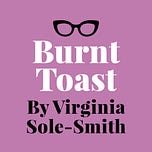




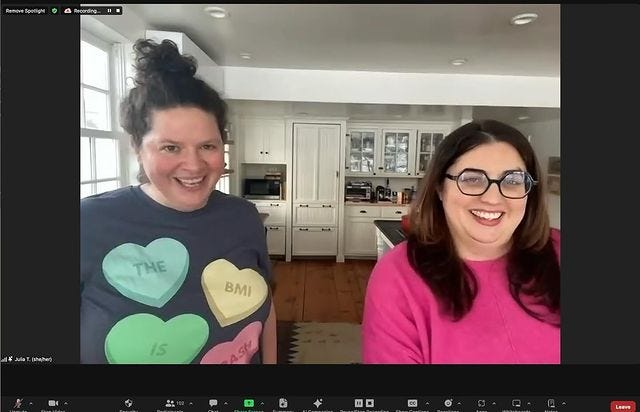
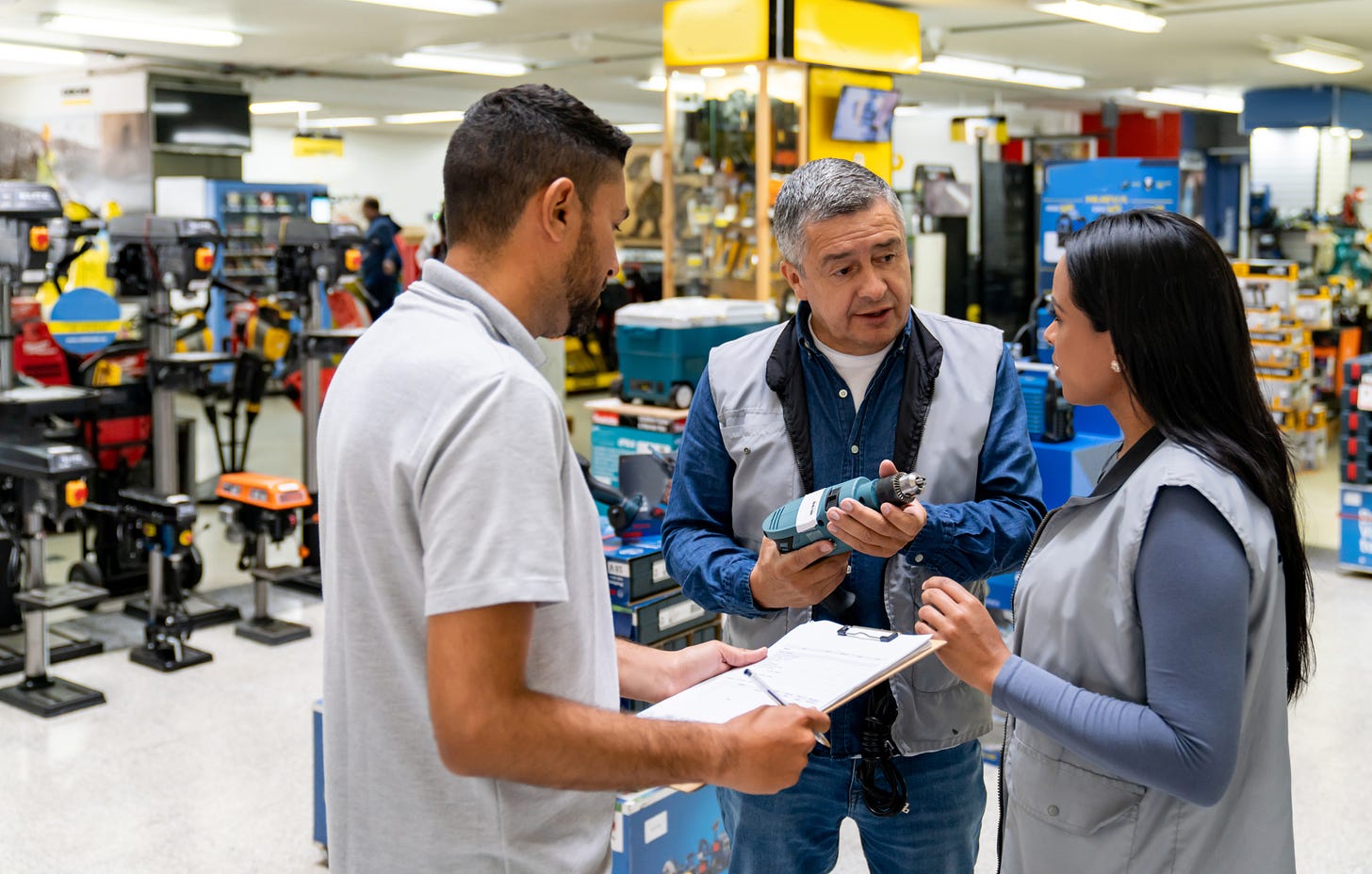

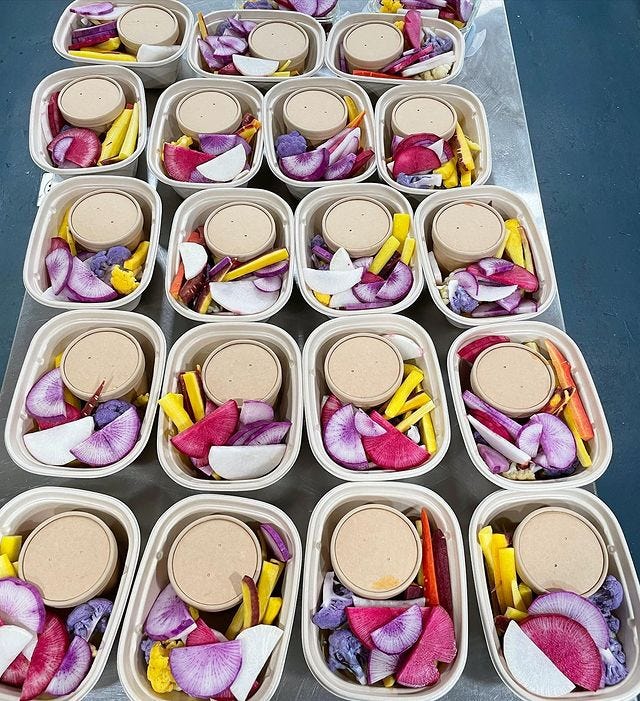
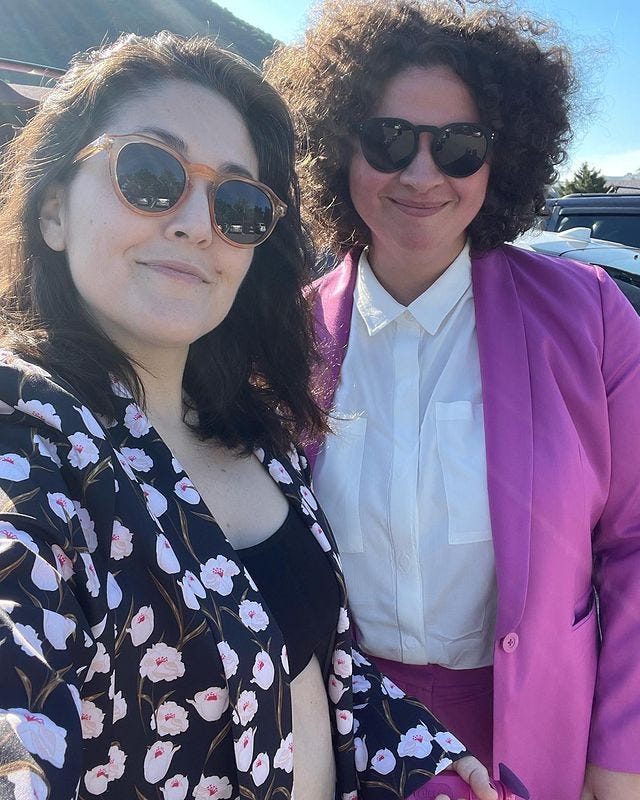
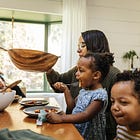

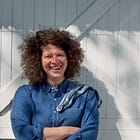
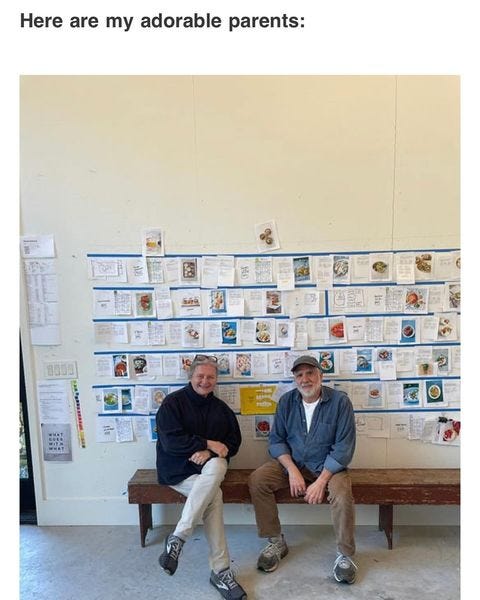






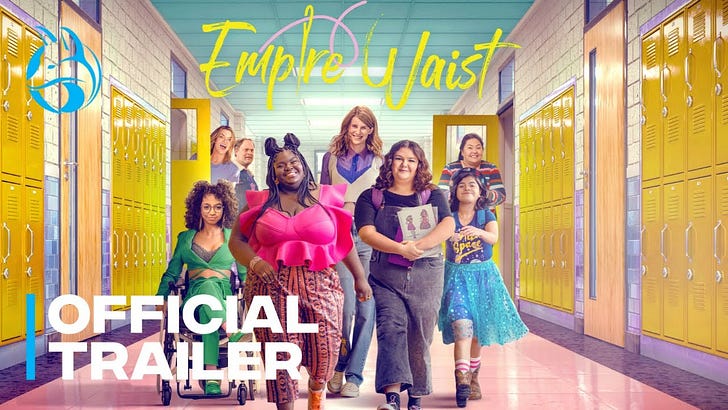


Julia Turshen Is Your Home Depot Dad